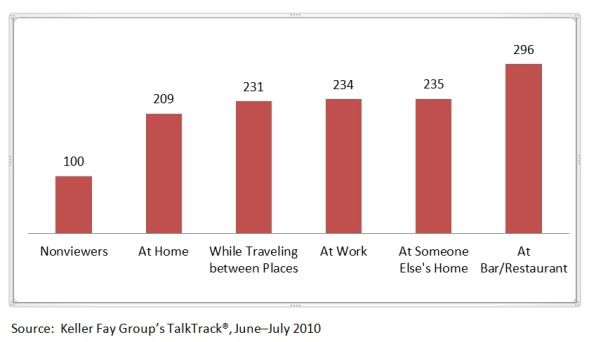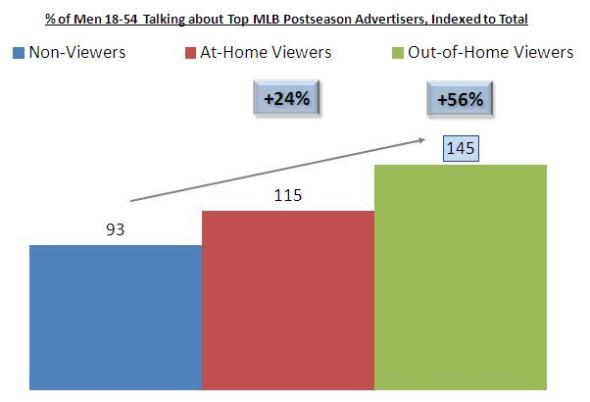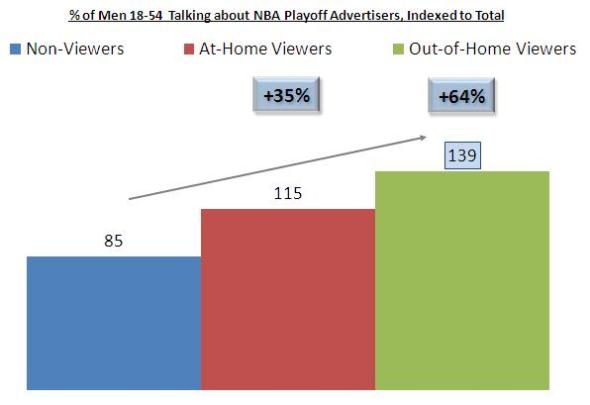The Super Bowl is Just One Example of the Power of Social Viewing - Ed Keller

The Super Bowl is upon us, and with it anticipation about the advertising is heating up. Some say that interest in the ads is as great, or greater, than interest in the game itself.
There is no question that the Super Bowl generates not only a large viewing audience but also tremendous buzz – offline and online – about the ads. Rather than being a once a year phenomenon, however, the Super Bowl is merely one in a series of programming options each year that proves an important fact: Co-viewing of sporting events and family-oriented television programming is a boon to advertisers because the spark significantly elevates levels of consumer conversation about the ads. When people watch television with other people, whether it be with family members or friends, at home or out of the home, they are considerably more likely to engage in conversation about the advertised brands. We have seen this at work with the Super Bowl as well as in research during the 2010 World Cup for ESPN, and during the 2011 NBA Playoffs and the 2012 MLB Playoffs for Turner Sports among other events.
What is so important about this research is that it flies in the face of what some consider to be conventional wisdom, which is that watching television with other people in the room is apt to distract people from the advertising breaks. This point of view was put forward in 2011 study called "How Co-Viewing Reduces the Effectiveness of TV Advertising" which reported that "commercials that were co-viewed were only 68% as effective as the same commercials solus viewed."
We came at our research on the topic by looking at a metric of ad engagement which is based on the extent to which viewers talk about the advertised brands, either with each other during the game watched, or soon afterward. Given the mounting evidence that word of mouth leads to enhanced sales as well as marketing effectiveness, we believe the goal of all advertising should be to spark conversations about the advertised brands and therefore WOM is a powerful metric by which to judge success.
Our first in-depth investigation of social viewing came during the 2010 FIFA World Cup and was conducted on behalf of ESPN. We measured word of mouth about the advertisers among those who watched the World Cup at home versus away from home. Among those who watched the World Cup at home, word-of-mouth levels about the seven main sponsors were, on average, twice as high as they were among non-viewers, providing evidence that viewership was helping to drive word of mouth for those brands. Among those who watched the game in a bar or restaurant, word-of-mouth levels were three times as high. Far from distracting, the ads appear to be social currency providing people watching together with something interesting to talk about.
Watching the World Cup 2010 in Social Environments Leads to Higher Levels of Advertiser WOM
Percentage engaging in WOM about World Cup advertisers in the past day, indexed to non-viewers

We continued to pursue the thesis that co-viewing leads to more conversation about advertised brands when we studied the 2012 Major League Playoffs and the 2011 NBA Playoffs on behalf of Turner Sports. We found that among the target audience (males 18-54), viewers of the 2012 Major League Playoffs, at-home viewers talked about advertised brands 24% more than non-viewers, while out-of-home viewers talked 56% more.
Out-of-Home Viewers Far More Likely to Talk About Advertisers vs. At-Home Viewers

Source: Keller Fay Group's TalkTrack®, Oct. 1st – Oct. 21st, 2012
During the NBA Playoffs an even stronger picture emerged to prove the power of the out-of-home audience. At-home viewers talked about advertised brands 35% more than non-viewers, while out-of-home viewers talked 64% more.
NBA Advertiser WOM Highest for Out-of-Home Viewers

Source: Keller Fay Group's TalkTrack®, May 16th – May 29th, 2011
Taken as a whole, this series of research studies shows that the Super Bowl is not unique, merely the biggest in a series of opportunities for advertisers to tap the power of social marketing with the right ads that reach people when they are in social settings. And while we've not yet conducted studies among the audiences for family-oriented dramas, comedies, and reality programs, we have every reason to believe we will see a similar pattern.
This research gives television executives a new reason to focus on programming that appeals to the whole family—it's not just good for family life and ratings, but it offers advertisers a big "social" value that's unique to television.
Ed Keller, CEO of the Keller Fay Group, has been called "one of the most recognized names in word of mouth." His new book, The Face-to-Face Book: Why Real Relationships Rule in a Digital Marketplace, was recently published by Free Press/Simon & Schuster. You can follow Ed Keller on Twitter, Facebook and Google+, or contact him directly at ekeller@kellerfay.com.
Read all Ed’s MediaBizBloggers commentaries at WOM Matters.
Check us out on Facebook at MediaBizBloggers.com
Follow our Twitter updates @MediaBizBlogger
The opinions and points of view expressed in this commentary are exclusively the views of the author and do not necessarily represent the views of MediaBizBloggers.com management or associated bloggers. MediaBizBloggers is an open thought leadership platform and readers may share their comments and opinions in response to all commentaries.


